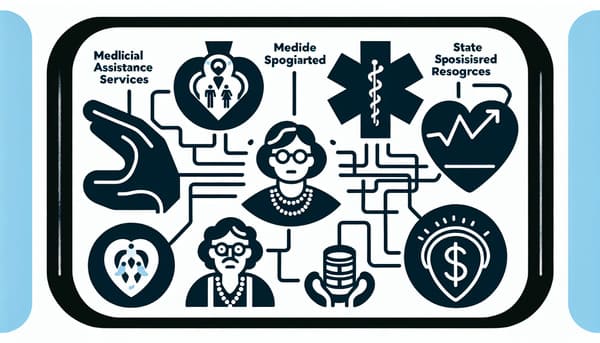
by Russell Noga | Updated March 24th, 2024
As Oregon’s healthcare landscape shifts, so do your options for Medicare supplement plans. In this guide, we will focus on Medicare supplement plans Oregon 2025, equipping you with the latest information on Plan G, regulatory updates, and the strategies for choosing a plan that aligns with your healthcare needs. Avoid the guesswork and understand exactly what these changes mean for you.
Key Takeaways
- Oregon introduced significant regulatory changes in 2025, including guaranteed access to Medicare Supplement Plan G for new enrollees and streamlining medication access by allowing biosimilar formulary substitutions without prior approval.
- Medigap Plans F, G, and N are popular choices in Oregon, with Plan G providing extensive coverage, excluding only the Part B deductible, while Plan N offers lower premiums in exchange for copayments for certain visits.
- Oregonians have a range of financial assistance options for Medicare supplement plans, including the Oregon Health Plan (OHP), which assists with premiums, deductibles, and coinsurance, as well as specialized programs for groups such as Qualified Medicare Beneficiaries.
Compare 2025 Plans & Rates
Enter Zip Code
Oregon's Medicare Landscape in 2025

Surveying the Oregon Medicare landscape of 2025, we note:
- A pronounced increase in the number of Medicare beneficiaries, a trend growing steadily by 4% since 2023.
- This increase is not just a number but a reflection of the lives and health of Oregonians who rely on Medicare for their well-being.
- Responding to this surge, Oregon has introduced a crucial regulatory change: guaranteeing access to Medicare Supplement Plan G for all new Medicare enrollees from 2025 onwards.
- This plan stands as a beacon of comprehensive coverage, excluding only the Part B deductible, and is a cornerstone of the healthcare landscape for many.
The backdrop to this uptick in beneficiaries isn’t just regulatory adjustments; it’s also the demographic reality that Oregon’s population, particularly those over 65, has burgeoned, leading to a heightened demand for Medicare supplement plans. This demographic shift, more than just a statistic, represents a community adapting to an aging populace and the healthcare needs that come with it. As we delve deeper, we’ll explore how these changes affect the choices available to you and how you can best prepare for these evolving healthcare needs.
Regulatory Changes
Examining recent regulatory changes, we discover that they’re reshaping the Medicare landscape. A noteworthy shift comes with CMS’s proposal for uniform compensation for agents and brokers, which was designed to prevent biases in plan enrollment. Imagine a world where the advice you receive regarding your healthcare coverage, including prescription drug options, is untainted by financial incentives – this is the ideal that the new rules strive to achieve. Moreover, biosimilar formulary substitutions can now occur without prior approval, streamlining the process for beneficiaries to receive necessary medications.
Regulatory changes don’t end there; amended network adequacy standards have expanded the inclusion of behavioral healthcare providers, giving mental health the necessary focus. Plans must notify beneficiaries mid-year of unused supplemental benefits and demonstrate that benefits for the chronically ill are research-based and expected to improve health outcomes. These changes are like fresh tributaries feeding into the river of Medicare, each bringing its own contribution to a more equitable and efficient healthcare system.
Enrollment Trends
Monitoring enrollment trends, we observe a sharp increase in Oregon’s Medicare enrollees, surpassing even the general population growth rates. This swell can be partially traced to the retirement of baby boomers, those born in the post-World War II era, who are now reaching Medicare eligibility age. Like a wave gathering strength, the retirement of this sizable demographic has had a pronounced impact on the Medicare enrollment landscape.
However, the growth isn’t only due to retirees; Oregon’s influx of new residents, especially from neighboring California, also contributes to the rise in Medicare supplement plan enrollees. This migration brings with it a diversity of health needs and preferences, adding to the complexity and vibrancy of the state’s healthcare ecosystem. As these trends continue, they will undoubtedly shape the future of Medicare in Oregon, influencing both the availability and choice of supplement plans.
Demographic Shifts
Within Oregon’s healthcare landscape, demographic shifts gradually modify the environment, much like the changing seasons. The state’s elderly population percentage has seen an upward trend, much like the majestic growth of Oregon’s Douglas firs. With more residents enjoying their golden years, the demand for Medicare supplement plans has naturally flourished, growing in tandem with this demographic shift.
Forecasts suggest that this pattern will persist, with the population aged 65 and over projected to continue its growth. This burgeoning senior population isn’t just a testament to Oregon’s quality of life; it’s a clarion call for a healthcare system that can adequately support the needs of its aging citizens. As we ponder the future, it’s evident that Medicare supplement plans will play an increasingly important role in meeting the healthcare demands of Oregon’s seniors.
Comparing Medicare Supplement Plans in Oregon

When considering Medicare Supplement Plans in Oregon, it’s evident that a multitude of options exist, each with unique benefits and considerations. Oregonians are fortunate to have access to all 10 standardized Medigap plans, providing the assurance that basic benefits remain constant across different insurance companies. This standardization is akin to a map legend, guiding beneficiaries through their coverage options with clarity and consistency.
Within the array of Medigap plans, Plans F, G, and N stand out as prominent landmarks, each offering distinct coverage to navigate the terrain of healthcare expenses. Plan G, in particular, has garnered favor for its extensive coverage, enticing those who prefer not to manage the Part B deductible. Meanwhile, Plan N appeals to those who are prepared to pay copayments for doctor and emergency room visits in exchange for lower premiums. As we scrutinize these plans, we’ll consider how the balance of benefits, costs, and provider flexibility can influence your journey through Medicare Supplement coverage.
Plan Benefits
Upon examining the diverse range of Medicare Supplement plans, one realizes that benefits often dictate the optimal path for a beneficiary’s healthcare journey. In Oregon, Plan G stands tall as the most comprehensive option, covering Part A deductible and foreign travel emergencies while leaving the Part B deductible as the only uncovered territory. This plan is like a trusty all-terrain vehicle, ready to take on most healthcare challenges that come its way.
For those who were eligible before 2020, Plan F is like a full-service guide, covering all out-of-pocket expenses not already paid for by Medicare, leaving beneficiaries with a sense of security and minimal financial surprises. Other Medicare plans, like Plan A and Plan K, offer varying levels of coverage, ensuring there’s a fit for every type of traveler through the healthcare system. And while standard Medigap policies in Oregon don’t cover long-term care or expenses covered by other insurance policies, they do provide a layer of financial protection that can be indispensable in times of need.
Premium Costs
While benefits are vital, premium costs significantly influence the choice of a Medigap plan in Oregon. Just as the state’s topography varies from the rugged coastlines to the serene high desert, so do Medigap premiums. These premiums can range widely based on personal factors such as:
- age
- gender
- tobacco use
- geographical location within the state
Premiums for plans such as A, G, or N can span from a modest $91 to a more considerable $323 per month, indicative of the diverse policy landscape available to Oregonians.
The rating method of the policy—whether it’s community-rated, issue-age-rated, or attained-age-rated—also plays a significant role in determining the ebb and flow of premium costs over time. This variability underscores the importance of understanding not just the current cost, but the potential financial trajectory of a Medigap plan. Therefore, when considering the long-term journey of healthcare coverage, it’s essential to navigate the premium landscape with a keen eye on both present expenses and future financial horizons.
Provider Networks
One of the most liberating aspects for beneficiaries while exploring Medicare Supplement plan options is the flexibility of provider networks. Unlike Medicare Advantage plans, which often chart a course through specific networks and require referrals for specialist visits, Medigap plans allow individuals the freedom to visit any provider that accepts Medicare. This is akin to having an open waterway, free of the restrictions that can often slow down or complicate a healthcare journey, such as those found in a Medicare advantage plan.
While specific information on provider networks for Medigap plans in Oregon for the year 2025 is not currently available, the existing framework offers a reassuring level of continuity and consistency. The absence of network limitations ensures that beneficiaries can seek the best possible care without concern for network boundaries or additional out-of-network charges. This level of choice and accessibility is a cornerstone of Medigap’s appeal, granting Oregonians the peace of mind that their health care can keep pace with their individual needs, wherever they may lead.
Eligibility and Enrollment for Oregon Residents
Understanding the eligibility and enrollment for Medicare Supplement plans in Oregon is similar to grasping the prerequisites for a journey. For residents, the starting point is enrollment in both Medicare Part A and Part B, a foundational step without which the path to a Medigap plan cannot begin. This enrollment serves as the compass that guides individuals through the subsequent steps of the enrollment process, ensuring they stay on the right track.
The open enrollment period marks a crucial time frame for Oregonians, providing a six-month window starting on the first day of the month in which an individual turns 65 and is enrolled in Medicare Part B. This period is much like the optimal weather window for setting sail; it’s the ideal time to secure Medigap coverage at the best rate, with insurers required to offer plans without denial based on health status. Understanding these enrollment nuances helps beneficiaries navigate the process with confidence, knowing they’re taking advantage of the best opportunities for coverage.
Eligibility Criteria
Examining the eligibility criteria for Medicare Supplement plans in Oregon; we find a state mandate requiring insurers to provide Medigap options to any resident eligible for Medicare. This inclusivity extends to individuals under the age of 65, including those with disabilities, end-stage renal disease, or ALS, who are likewise granted access to Medigap plans. Oregon’s approach is a testament to its commitment to healthcare accessibility, ensuring that the protections and benefits of Medigap plans are within reach for all eligible residents, regardless of age or health condition.
This open-door policy is particularly significant in light of federal rules that do not guarantee such access for those under 65. In Oregon, the trails of healthcare coverage are made clear and accessible, signifying a state that values the health and well-being of all its residents. As beneficiaries consider their eligibility for Medigap coverage, they can do so knowing that Oregon supports a comprehensive and inclusive approach to healthcare.
Enrollment Periods
Enrollment periods in Oregon provide distinct opportunities for Medicare beneficiaries to secure their health coverage. The initial six-month Medigap open enrollment period is akin to a season of opportunity, a time when the conditions are most favorable for enrolling in a plan that offers the best possible terms. During this prime window, the landscape of options is at its most bountiful, with no coverage denials or inflated premiums due to health status.
Oregon further enriches the enrollment terrain with its unique ‘birthday rule,’ which allows residents to change their Medigap policy without underwriting within 31 days of their birthday each year. This annual event is like a recurring tide, granting beneficiaries the chance to reassess and adjust their coverage to better suit their evolving healthcare needs. Additionally, guaranteed issue rights come into play within 63 days of losing certain types of health coverage, ensuring that even when life’s circumstances shift, Oregonians have paths to maintain their Medicare Supplement coverage.
Application Process
Similar to any important journey, the application process for a Medicare Supplement plan necessitates meticulous preparation and attention to detail. Prospective policyholders in Oregon must provide proof of current or previous health coverage and may need to share information regarding:
- Health status
- Age
- Gender
- Smoking habits
- Marital status
This step is akin to gathering the necessary provisions and charting the course before setting sail.
To embark on the application process, individuals should:
- Reach out to their chosen insurance company during their open enrollment period or upon having guaranteed issue rights.
- Complete an application form.
- Select when the coverage should start, much like choosing the departure date for a trip.
This attention to timing and detail ensures that the transition to new coverage is smooth, with no unexpected detours or delays. With these navigational tools in hand, Oregon residents can confidently set course toward their ideal Medicare Supplement plan.
Compare Medicare Plans & Rates in Your Area
Financial Assistance Options for Oregon Medicare Beneficiaries

Even the most well-prepared individuals may require assistance, and this holds true for Medicare beneficiaries in Oregon. Navigating the financial aspects of healthcare can be challenging, but thankfully, a variety of financial assistance options exist to help steady the ship. These options include Medicaid services, state-sponsored programs, and nonprofit resources, each offering different types of support to ensure that beneficiaries can afford the care they need.
Oregon’s Health Plan (OHP) is a lifeline for many, assisting with Medicare premiums, deductibles, and coinsurance and even providing additional coverage for services not included in Medicare. This additional coverage can include essential services such as transportation to medical appointments and dental care, akin to ensuring that all necessary supplies are on board for a successful voyage. For beneficiaries, understanding these financial assistance options is paramount, as they can significantly reduce out-of-pocket costs and provide a more secure and comprehensive healthcare experience.
Medicaid Services
Delving further into financial assistance, Oregon’s Medicaid services provide a substantial safety net beneath the extensive Medicare coverage. The Oregon Health Plan (OHP), for instance, extends its helping hand beyond the reach of Medicare, assisting with costs that would otherwise burden beneficiaries, such as premiums, deductibles, and co-insurance. Moreover, the plan includes services not typically covered by Medicare, like dental care and transportation to medical appointments, ensuring comprehensive care that covers all bases.
Furthermore, Qualified Medicare Beneficiaries (QMB) with OHP coverage are enrolled in a benefit package that allows the Oregon Health Authority (OHA) to pay for Medicare cost-sharing expenses, although Part D prescription drug coverage remains under original Medicare. This melding of OHP and Medicare benefits through Coordinated Care Organizations (CCOs) ensures beneficiaries receive seamless medical, dental, and mental health coverage. Through these Medicaid services, the financial barriers that can impede access to necessary health care are significantly lowered, allowing beneficiaries to navigate their health needs with greater ease and confidence.
State-Sponsored Programs
State-sponsored programs in Oregon serve a crucial role in the financial assistance system, guiding and supporting beneficiaries seeking additional help. These programs, like the integration of OHP and Medicare benefits through Coordinated Care Organizations (CCOs), offer a cohesive approach to managing healthcare needs and addressing health-related social needs.
By combining resources from both the federal government and state initiatives, Oregon ensures that its residents do not have to navigate the complex waters of healthcare financing alone. This integration exemplifies a commitment to providing accessible, high-quality care for all, echoing Oregon’s broader ethos of community and support and promoting health equity.
Nonprofit and Community Resources
Beyond government-funded programs, nonprofit and community resources act as beacons, guiding beneficiaries through the complexities of healthcare costs. These organizations provide support and guidance for those seeking financial assistance, ensuring that no one has to face the high seas of healthcare expenses without a knowledgeable crew at their side.
By tapping into these resources, Medicare beneficiaries can find the additional support they need to cover out-of-pocket costs, gain access to necessary services, and ultimately maintain their health without the weight of financial stress through traditional Medicare.
Tips for Choosing the Right Medicare Supplement Plan in Oregon

As healthcare trends constantly evolve, selecting the right Medicare Supplement Plan in Oregon can be as daunting as navigating uncharted waters. However, with a few navigational tips, the process can become a voyage of discovery rather than a source of trepidation. Key considerations include assessing individual healthcare needs, comparing costs and coverage, and consulting with experts and resources that can provide tailored advice and guidance.
To ensure a smooth journey, it’s critical to balance potential out-of-pocket expenses with the extent of coverage needed. Additionally, beneficiaries should look for plans that offer the flexibility to be covered by any healthcare provider that accepts Medicare, as this allows for a broader choice and accessibility. Whether you’re setting sail for the first time or are a seasoned traveler in the world of Medicare, these tips will help you find the Medicare Supplement Plan that best suits your individual healthcare needs and financial situation.
Assessing Health Care Needs
Before choosing a Medicare Supplement Plan, it’s important to assess your healthcare needs with the accuracy of a cartographer mapping new territories. Consider factors such as frequency of travel, the necessity for specialist care, and the importance of provider flexibility. For those who often travel or live in rural areas of Oregon, Medigap plans provide the advantage of nationwide coverage without network restrictions, ensuring that healthcare is accessible no matter the location.
Moreover, unlike Medicare Advantage plans, Medigap policies in Oregon offer the following benefits:
- Members can see specialists without referrals
- Members have the autonomy to choose their own healthcare providers
- Members have coverage for emergency care during travel
By thoroughly assessing personal healthcare requirements, including potential needs for specialists or emergency care during travel, beneficiaries can ensure that their chosen plan aligns with their lifestyle and healthcare demands, much like a compass aligns with true North.
Comparing Costs and Coverage
The next step is to compare the costs and coverage of different Medicare Supplement Plans, much like evaluating the merits of different paths on a map, taking into account both the terrain and the distance of each route.
In Oregon, Medigap plans offer the significant advantage of no provider network restrictions, meaning network boundaries do not constrain beneficiaries and won’t incur out-of-network charges. This provides greater flexibility and cost predictability compared to Medicare Advantage plans, which may limit the choice of healthcare providers.
When comparing costs, it’s important to consider not only the premiums but also the out-of-pocket expenses that may be incurred throughout the year. This includes copayments for doctor visits, deductibles, drug costs, and any other potential costs that might arise from healthcare services.
By carefully evaluating both the costs and the extent of coverage, beneficiaries can steer their way to a Medigap plan that offers the best value for their healthcare dollars, ensuring a secure and financially sound healthcare journey.
Consulting Experts and Resources
Lastly, the journey through Medicare Supplement Plans in Oregon is eased with the aid of expert guides – the resources available to assist beneficiaries through the decision-making process. Organizations such as Oregon’s State Health Insurance Assistance Program (SHIP) and the Senior Health Insurance Benefits Assistance (SHIBA) offer trained counselors who can provide informed advice on selecting a Medigap plan. These counselors act as lighthouses, illuminating the complexities of Medicare and helping beneficiaries avoid the pitfalls of choosing a plan that may not fully meet their needs.
These resources, along with certified Senior Advisors (CSA) and licensed Medicare agents, provide detailed insights into:
- Enrollment periods
- Premiums
- Policies for pre-existing conditions
- And much more
By consulting with these experts, beneficiaries can gain a deeper understanding of the local premiums and nuances of Medigap plans, ensuring that the choice they make is well-informed and tailored to their unique circumstances.
With the right guidance, the journey to selecting a Medicare Supplement Plan can be navigated with confidence and ease, leading to a future of secure and comprehensive healthcare coverage.
Summary
As we dock at the conclusion of our journey through the Medicare Supplement Plans in Oregon for 2025, it’s clear that the landscape is rich with options and opportunities. From understanding the evolving Medicare landscape with its regulatory changes and demographic shifts to comparing the various Medigap plans and navigating the eligibility and enrollment processes, Oregonians are well-equipped to make informed decisions about their healthcare coverage. Remember, navigating these waters successfully requires a keen understanding of one’s healthcare needs, a careful comparison of costs and coverage, and a willingness to consult experts and resources.
Embark on this journey with the knowledge that each decision you make shapes your healthcare experience. With the right Medicare Supplement Plan, you can chart a course that ensures access to the care you need with financial peace of mind. Let this guide serve as your compass, pointing you toward a future of health and well-being as you navigate the waters of Medicare in Oregon.
Compare 2025 Plans & Rates
Enter Zip Code
Frequently Asked Questions
What are the changes to Medicare in 2025?
In 2025, Medicare beneficiaries will pay 25 percent of drug costs after the initial deductible, with a cap of around $3,300, and no longer paying five percent in the catastrophic phase, while the Part A deductible will be $1,632 per stay. The standard monthly Part B premium will increase to $174.70.
What is the projected Medicare Advantage enrollment in 2025?
By 2025, the projected Medicare Advantage enrollment is expected to reach 35.4 million beneficiaries, up from 21.3 million in 2018.
Are Medicare Supplement plans being phased out?
Yes, Medicare Supplement Plan F is being phased out starting January 1, 2020. However, those who currently have Plan F can keep it indefinitely. If you become eligible for Medicare after January 1, 2020, you won’t be able to purchase a Plan F.
What are the eligibility criteria for Medicare Supplement Plans in Oregon?
To be eligible for a Medicare Supplement Plan in Oregon, you need to be enrolled in both Medicare Part A and Part B. The state also requires insurers to offer Medigap options to all residents eligible for Medicare, including those under 65 with disabilities.
How do the premium costs of Medigap plans in Oregon vary?
The premium costs of Medigap plans in Oregon can vary based on age, gender, tobacco use, geography, and the insurance company offering the plan. These factors can result in monthly premiums ranging from $91 to $323, with different rating methods impacting long-term costs.
Speak to the Professionals about Medigap Plans and Original Medicare
If you find understanding the benefits involved with Original Medicare and Medigap Plans challenging, you’re not alone. Whether it’s a Medigap plan, or you want to know more about Medicare Supplement Plans Oregon in 2025, we can help. Call our team at 1-888-891-0229 for a free consultation or complete the contact form on this site, and an expert will call you back at a convenient time.
We have decades of experience advising our clients on the complexities of Medicare and Medigap plans, the benefits, cost and deductibles. We’ll ensure you get the best rate in your state and advice you can trust.



